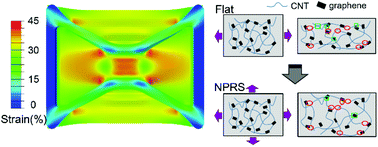Strain-sensitive electrical conductivity of carbon nanotube-graphene-filled rubber composites under cyclic loading†
Abstract
Conductive rubber nanocomposites have been attracting interest for strain sensing applications owing to their large deformation and high sensitivity. In this paper, the strain sensing behavior of room temperature vulcanized (RTV) hybrid silicone rubber composites containing carbon nanotubes and graphene was systematically investigated. We studied the effects of the nanofiller content and strain amplitude on the strain sensing behavior of the nanocomposites, and found good stability and durability during cyclic loading. The shoulder peaks appeared in the cyclic loading curves owing to the competition between the reconstruction process of the conductive network during deformation and time-dependent features of the polymer material. Furthermore, our test results of different loading histories indicated that a sufficient recovery time could reduce or even eliminate the shoulder peak. Finally, the mechanical structure with a negative Poisson's ratio is designed to regulate the resistance response of the RTV nanocomposites, exhibiting a monotonic and more sensitive resistance response. Our research results explain the main factors contributing to the shoulder peak phenomenon of conductive nanocomposites and provide a regulation strategy for achieving a monotonic and highly sensitive resistance response.

- This article is part of the themed collection: International Year of the Periodic Table : Low Dimensional Carbon Systems


 Please wait while we load your content...
Please wait while we load your content...